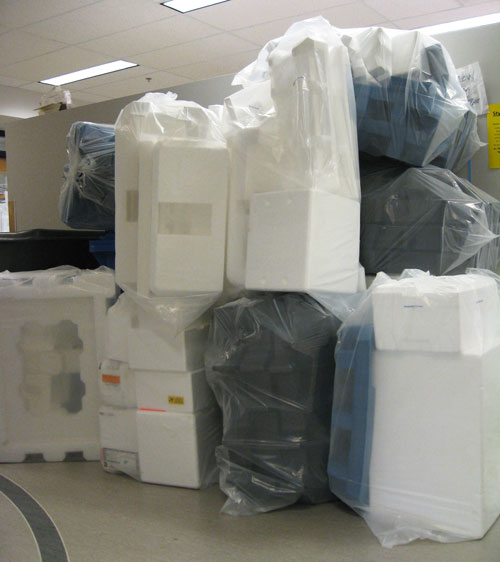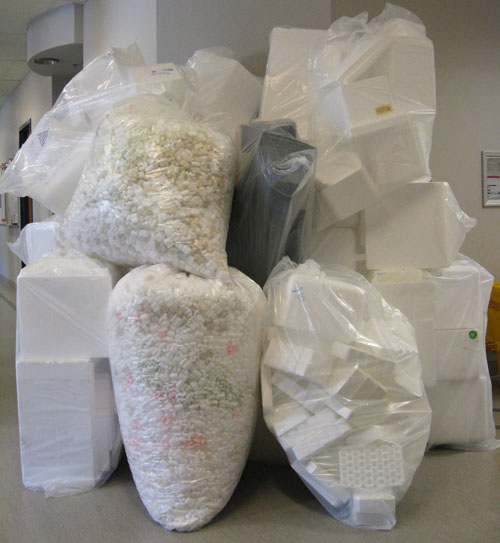Developed at UBC in 1999, the Sustainability Coordinator (SC) Program engages employees at UBC’s Vancouver, Robson Square and Teaching Hospital sites, providing them with the support, awareness, skills and tools needed to foster sustainability in their own department. Melissa Ashman, SC for the Brain Research Centre (BRC), recently co-presented with Melanie Bertrand on the results of their ongoing Styrofoam Reduction pilot project. The event’s waitlist pointed to a high level of interest in the subject so we contacted Ashman for an exclusive interview.
Interview by Tracy Bains of Campus & Community Planning, responses by Melissa Ashman.
C+CP: How did you get involved in this project?
Ashman: I became a Sustainability Coordinator at the BRC about two years ago. First, I tackled getting plastics 1-7 and tin recycled with the help of UBC Hospital facilities and housekeeping staff. Then, I wondered about Styrofoam.
As an SC, I am one of 150 staff and faculty members who advocate for sustainable practices in 300 departments across UBC’s Vancouver campus.
C+CP: Why Styrofoam?
Ashman:The BRC represents 12 labs located at UBC Hospital—that’s 50,000 square feet of research space. Before the pilot, about 95% of shipments to the BRC were coming in Styrofoam boxes and/or with Styrofoam chips. All of it was being shipped to the landfill.
C+CP: Once you targeted Styrofoam, what was your next move?
Ashman: I work at an office in the BRC—not a lab. I realized that I needed Melanie, a laboratory manager at the facility, on board in order to successfully tackle waste reduction in the lab—particularly Styrofoam. Together, we submitted a proposal to the Xerox Workplace Sustainability Fund administered by the Campus and Community Planning: Programs and Animation office. We were awarded $950 to fund a Styrofoam recycling project which has since morphed into a Styrofoam reduction project.
C+CP: How did the shift from recycling to reduction occur?
Ashman: Since we’re paying to recycle Styrofoam at $5 a bag, we don’t want pay for more than we have to. We started stockpiling Styrofoam in August 2009; over the last 10 months, we have recycled 56 large bags of Styrofoam. To maximize the amount recycled in each bag, we stack boxes and pieces inside each other.
At the same time, we’ve been trying to reduce the use of Styrofoam. Melanie has been working closely with vendors to avoid the use of Styrofoam and/or to reduce the volume of Styrofoam used when shipping items to BRC. Also, a few companies accept their Styrofoam boxes returned back to them. We have partnered with UBC Hospital and Campus Mail services to ensure that these boxes can be accommodated when returned by mail.
C+CP: How have the vendors responded to your requests?
Ashman: Some companies are already in the process of reducing Styrofoam or changing their packaging. Others have responded by reducing box sizes and removing chips or using alternatives in their packages. Still, there have been some companies that have not responded at all.
When companies have worked with us, we’ve thanked them. When companies slip up, we remind them.
C+CP: Why do you believe vendors have responded positively to this pilot?
Ashman: We asked companies to stop shipping in Styrofoam or we wouldn’t do business with them. Fortunately, most companies listened and responded to our requests.
C+CP: How about your colleagues? Are they responding too?
Ashman: Generally, staff, faculty, and students are doing well. There’s a learning curve--sometimes boxes that can be returned to the vendor are sometimes still placed in the bin for recycling. But I think we have seen significant strides. For example, the volume of Styrofoam has dropped off significantly over the past 10 months. We started recycling 13-18 bags of Styrofoam, but our most recent pick-up a few days ago was only 7 bags--quite a difference.

December 2009

April 2010
C+CP: Once the pilot ends, what do you hope will happen?
Ashman: I’d like to see all vendors and companies stop shipping materials in Styrofoam. Ultimately, I’d like to see the Styrofoam reduction initiative get rolled out campus-wide as an official waste management strategy.
What Ashman and Bertrand’s Styrofoam Reduction pilot demonstrates is that reducing waste in labs—or elsewhere—involves more than recycling. Waste reduction begins at the point of ordering. We can make better choices on behalf of the university—like choosing “greener” shipping materials or grouping orders to minimize packaging—to help UBC become more sustainable. Interested in learning more or becoming a Sustainability Coordinator?